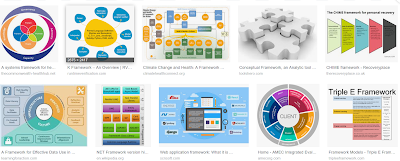"By bringing these key aspects together on a process-oriented strategy, organizations are able to acquire agility and improve the ability to engage on a much more effective way. This translates into a solid, resilient and innovative framework that drives the ability to continuously improve and assure sustainability."Does that actually mean anything? What does it take for a "framework" to be simultaneously solid and resilient, let alone innovative?
If you take a random set of concepts - social, mobile, analytics, cloud, internet of things - you can string the initial letters into a slightly suggestive acronym - SMACIT. But have you got a framework?
And if you take a random set of ideas and arrange them artistically, you can create a nice diagram. But have you got a framework, or is this just Methodology by PowerPoint?
Most diagrams are just lists in boxes circles and hexagons arranged to imply the geometry contains some relevant information - and obscure the arbitrary selection of item in the list.— ricphillips (@ricphillips) February 27, 2019
Meanwhile, Cameron Tokinwise notes a tendency to force-fit frameworks into a neat pattern.
how many otherwise useful conceptual frameworks have weak extra terms/components added so that the whole can then can be turned into a 2x2, or circle with 6, 8 or 12 segments, or comply with the rule of 3?
— cameron tonkinwise (@camerontw) April 12, 2021
The fallacy of pathetic formalism
I just did an image search for "framework" on Google. Here are the top ten examples. Pretty typical of the genre.
In 1987, John Zachman published an article in the IBM Systems Journal, entitled "A Framework for Information Systems Architecture", hypothesizing a set of architectural representations for information systems, arranged in a table. The international standard ISO/IEC 42010 defines an architectural framework as any set of architectural descriptions or viewpoints satisfying certain conditions, and the Zachman Framework is usually cited as a canonical example of this, along with RM/ODP and a selection of AFs (MOD, DOD, TOG, etc.).
But there are a lot of so-called frameworks that don't satisfy this definition. Sometimes there is just a fancy diagram, which makes less sense the more you look at it. Let's look at the top example more closely.
The webpage asserts that "the summary graphic illustrates the main relationships between each heading and relevant sub-headings". Sorry, it doesn't. What does this tell me about the relationship between Knowledge and Governance? If Advocacy is about promoting things, does that mean that Knowledge is about preventing things? And if Prevent, Protect and Promote are verbs, does this mean that People is also a verb? I'm sure there is a great deal of insight and good intentions behind this diagram, but the diagram itself owes more to graphic design than systems thinking. All I can see in this "systems framework" is (1) some objectives (2) a summary diagram and (3) a list. If that's really all there is, I can't see how such a framework "can be used as a flexible assessment, planning and evaluation tool for policy-making".
For clarification, I think there is an important difference between a framework and a lens. A lens provides a viewpoint - a set of things that someone thinks you should pay attention to - but its value doesn't depend on its containing everything. VPEC-T is a great lens, but is Wikipedia right in characterizing as a thinking framework?
Commonwealth Health Hub, A systems framework for healthy policy (31 October 2016)
Filipe Janela, The 3 cornerstones of digital transformation (Processware, 30 June 2017)
Anders Jensen-Waud, On Enterprise Taxonomy Completeness (9 April 2010)
John Zachman, A Framework for Information Systems Architecture (IBM Systems Journal, Vol 26 No 3, 1987).
Wikipedia: ISO/IEC 42010, VPEC-T
Related posts: What's Missing from VPEC-T (September 2009), Evolving the Enterprise Architecture Body of Knowledge (October 2012), Arguing with Mendeleev (March 2013)
Updated 28 February 2019, 12 April 2021
Added tweets by @ricphillips and @camerontonkinwise. See discussion following. I also remembered an old discussion with Anders Jensen-Ward.


No comments:
Post a Comment